-

新人教版高中英语选修2Unit 4 Using langauge-Listening教学设计
The theme of the listening section is " talking about scenery and culture along a journey."The part is designed to further lead the students to understand Canadian natural geography and social environment, and integrated into the cultural contrast by mentioning the long train journey from Beijing to Moscow routes. On this basis, the part activates students related travel experience, lets the student serial dialogue, guides the student to explore further the pleasure and meaning of the long journey, and Chinese and foreign cultural comparison.The part also provides a framework for the continuation of the dialogue, which is designed to provide a framework for students to successfully complete their oral expressions, and to incorporate an important trading strategy to end the dialogue naturally.1. Help students to understand and master some common English idioms in the context, and experience the expression effect of English idioms.2. Guide the students to understand the identity of different people in the listening context, and finish the dialogue according to their own experience.3. Instruct the students to use appropriate language to express surprise and curiosity about space and place in the dialogue, and master the oral strategy of ending the dialogue naturally.1. Instruct students to grasp the key information and important details of the dialogue.2. Instruct students to conduct a similar talk on the relevant topic.

新人教版高中英语选修2Unit 5 Learning about Language教学设计
The purpose of this section of vocabulary exercises is to consolidate the key words in the first part of the reading text, let the students write the words according to the English definition, and focus on the detection of the meaning and spelling of the new words. The teaching design includes use English definition to explain words, which is conducive to improving students' interest in vocabulary learning, cultivating their sense of English language and thinking in English, and making students willing to use this method to better grasp the meaning of words, expand their vocabulary, and improve their ability of vocabulary application. Besides, the design offers more context including sentences and short passage for students to practice words flexibly.1. Guide students to understand and consolidate the meaning and usage of the vocabulary in the context, 2. Guide the students to use the unit topic vocabulary in a richer context3. Let the students sort out and accumulate the accumulated vocabulary, establishes the semantic connection between the vocabulary,4. Enable students to understand and master the vocabulary more effectivelyGuiding the Ss to use unit topic words and the sentence patterns in a richer context.Step1: Read the passage about chemical burns and fill in the blanks with the correct forms of the words in the box.

新人教版高中英语选修2Unit 5 Reading and thinking教学设计
The theme of this activity is to learn the first aid knowledge of burns. Burns is common in life, but there are some misunderstandings in manual treatment. This activity provides students with correct first aid methods, so as not to take them for granted in an emergency. This section guides students to analyze the causes of scald and help students avoid such things. From the perspective of text structure and collaborative features, the text is expository. Expository, with explanation as the main way of expression, transmits knowledge and information to readers by analyzing concepts and elaborating examples. This text arranges the information in logical order, clearly presents three parts of the content through the subtitle, accurately describes the causes, types, characteristics and first aid measures of burns, and some paragraphs use topic sentences to summarize the main idea, and the level is very clear.1. Guide students to understand the causes, types, characteristics and first aid methods of burns, through reading2. Enhance students’ ability to deal withburnss and their awareness of burns prevention3. Enable students to improve the ability to judge the types of texts accurately and to master the characteristics and writing techniques of expository texts.Guide students to understand the causes, types, characteristics and first aid methods of burns, through readingStep1: Lead in by discussing the related topic:1. What first-aid techniques do you know of ?CPR; mouth to mouth artificial respiration; the Heimlich Manoeuvre

新人教版高中英语选修2Unit 2 Reading and thinking教学设计
Her tutor told her to acknowledge __________ other people had said if she cited their ideas, and advised her _______(read) lots of information in order to form __________wise opinion of her own.Now halfway __________ her exchange year, Xie Lei felt much more at home in the UK. She said __________ (engage) in British culture had helped and that she had been__________ (involve) in social activities. She also said while learning about business, she was acting as a cultural messenger __________(build) a bridge between the two countries. keys:Xie Lei, a 19yearold Chinese student, said goodbye to her family and friends in China and boarded (board) a plane for London six months ago in order to get a business qualification. She was ambitious(ambition) to set up a business after graduation. It was the first time that she had left (leave) home.At first, Xie Lei had to adapt to life in a different country. She chose to live with a host family, who can help with her adaptation (adapt) to the new culture. When she missed home, she felt comforted (comfort) to have a second family. Also Xie Lei had to satisfy academic requirements. Her tutor told her to acknowledge what other people had said if she cited their ideas, and advised her to read lots of information in order to form a wise opinion of her own.Now halfway through her exchange year, Xie Lei felt much more at home in the UK. She said engaging (engage) in British culture had helped and that she had been involved (involve) in social activities. She also said while learning about business, she was acting as a cultural messenger building a bridge between the two countries.

新人教版高中英语选修2Unit 3 Using langauge-Listening教学设计
1. How is Hunan cuisine somewhat different from Sichuan cuisine?The heat in Sichuan cuisine comes from chilies and Sichuan peppercorns. Human cuisine is often hotter and the heat comes from just chilies.2.What are the reasons why Hunan people like spicy food?Because they are a bold people. But many Chinese people think that hot food helps them overcome the effects of rainy or wet weather.3.Why do so many people love steamed fish head covered with chilies?People love it because the meat is quite tender and there are very few small bones.4.Why does Tingting recommend bridge tofu instead of dry pot duck with golden buns?Because bridge tofu has a lighter taste.5 .Why is red braised pork the most famous dish?Because Chairman Mao was from Hunan, and this was his favorite food.Step 5: Instruct students to make a short presentation to the class about your choice. Use the example and useful phrases below to help them.? In groups of three, discuss what types of restaurant you would like to take a foreign visitor to, and why. Then take turns role-playing taking your foreign guest to the restaurant you have chosen. One of you should act as the foreign guest, one as the Chinese host, and one as the waiter or waitress. You may start like this:? EXAMPLE? A: I really love spicy food, so what dish would you recommend?? B: I suggest Mapo tofu.? A: Really ? what's that?

新人教版高中英语选修2Unit 4 Learning about Language教学设计
This section guides students to pay attention to the typical context of vocabulary use, helps students accumulate vocabulary around the key vocabulary of this unit, and uses the learned words and word chunks in different contexts to deeply understand their meaning and usage, so as to achieve the purpose of review and consolidation.The teaching design activities aim to guide students to pay attention to the typical context in which the target vocabulary is used, as well as the common vocabulary used in collocation, so that students can complete the sentence with correct words. In terms of vocabulary learning strategies, this unit focuses on cultivating students' ability to pay attention to collocation of words and to use word blocks to express meaning.For vocabulary learning, it is not enough just to know the meaning of a single word, but the most important thing is to master the common collocations of words, namely word blocks.Teachers should timely guide students to summarize common vocabulary collocation, such as verb and noun collocation, verb and preposition collocation, preposition and noun collocation, and so on.1. Guide students to understand and consolidate the meaning and usage of the vocabulary in the context, 2. Guide the students to use the unit topic vocabulary in a richer context3. Let the students sort out and accumulate the accumulated vocabulary, establishes the semantic connection between the vocabulary,4. Enable students to understand and master the vocabulary more effectivelyGuiding the Ss to use unit topic words and the sentence patterns in a richer context.

新人教版高中英语选修2Unit 5 Using langauge-Listening教学设计
The theme of this section is to learn how to make emergency calls. Students should learn how to make emergency calls not only in China, but also in foreign countries in English, so that they can be prepared for future situations outside the home.The emergency telephone number is a vital hotline, which should be the most clear, rapid and effective communication with the acute operator.This section helps students to understand the emergency calls in some countries and the precautions for making emergency calls. Through the study of this section, students can accumulate common expressions and sentence patterns in this context. 1.Help students accumulate emergency telephone numbers in different countries and learn more about first aid2.Guide the students to understand the contents and instructions of the telephone, grasp the characteristics of the emergency telephone and the requirements of the emergency telephone.3.Guide students to understand the first aid instructions of the operators.4.Enable Ss to make simulated emergency calls with their partners in the language they have learned1. Instruct students to grasp the key information and important details of the dialogue.2. Instruct students to conduct a similar talk on the relevant topic.Step1:Look and discuss:Match the pictures below to the medical emergencies, and then discuss the questions in groups.
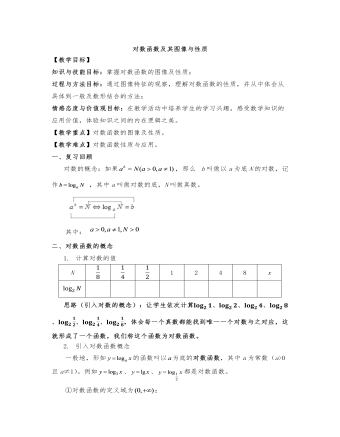
对数函数及其图像与性质高中数学教案
【教学目标】知识与技能目标:掌握对数函数的图像及性质;过程与方法目标:通过图像特征的观察,理解对数函数的性质,并从中体会从具体到一般及数形结合的方法;情感态度与价值观目标:在教学活动中培养学生的学习兴趣,感受数学知识的应用价值,体验知识之间的内在逻辑之美。【教学重点】对数函数的图像及性质。【教学难点】对数函数性质与应用。
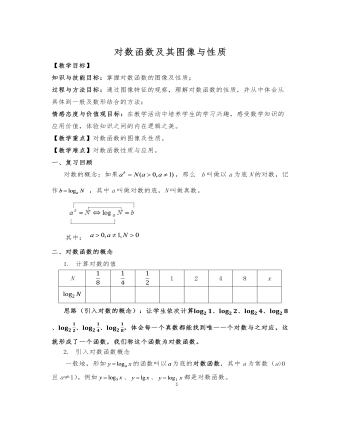
对数函数及其图像与性质高中数学教案
二、对数函数的概念1. 计算对数的值 N1248x 思路(引入对数的概念):让学生依次计算、、、、、、,体会每一个真数都能找到唯一一个对数与之对应,这就形成了一个函数,我们称这个函数为对数函数。
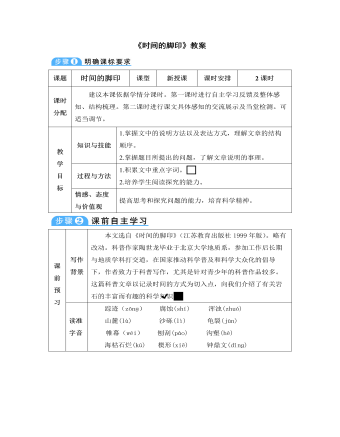
部编版语文八年级下册《时间的脚印》教案
【初读课文,整体感知】1. 以《时间的脚印》为题目有什么好处?文章的题目《时间的脚印》,是从高士其《时间伯伯》一诗中引申借用来的。其拟人化手法的运用,形象地说明了那些形形色色、大大小小的岩石中都潜藏着时间的踪影,以引起人们的探究欲望和阅读兴趣。【再读课文,梳理结构】1.第一部分(第1至第4自然段)说明岩石“是记录时间的方式中最重要的一种”。2.第二部分(第5至第29自然段)分层次地详细说明岩石是怎样记录时间的。这部分分三层。3.第三部分(第30自然段至全文完)总结全文,说明岩石记录时间的意义,号召人们进一步去大自然找寻时间的踪影,去一步步走向地下的宝库。【感悟精彩句子】1.“狂风来了,洪水来了,冰河爬来了”。
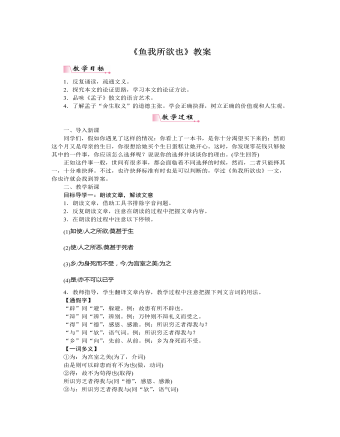
部编版语文九年级下册《鱼我所欲也》教案
明确:提出“生与义不可得兼,舍生而取义者也”的论点后,首先从正面指出人之所以能“舍生取义”,是因为人皆有“欲生不为苟得,恶死有所不辟”的思想。然后再从反面说明,如果人只是欲生恶死,那么什么事都可以做得出来;可是事实上,“义”超过了“生”,所以人能够不贪生,不避死。这种羞恶之心,人人皆有,贤者更能保持而不丧失。接着举例说明,以乞人不受不义之食为例,从正面论证“舍生取义”是人之共性。以万钟虽好也不能受为例,从反面强调了舍义取利是丧失本心。随后用一组排比句,对不辩礼义而贪求富贵的行为加以批判,并以“此之谓失其本心”收束全文,照应开头。3.列举本文主要的论证方法,并说明其作用。明确:(1)比喻论证。用比喻论证引出论点。以生活常理为喻引出生与义无法兼顾的情况下应该舍生而取义的结论(主旨)。
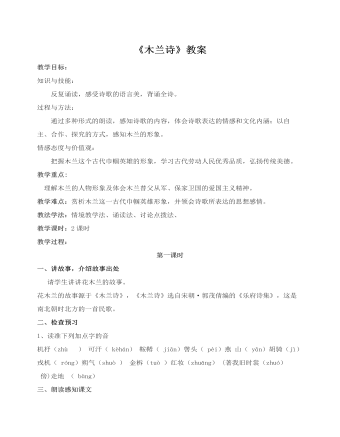
部编版语文七年级下册《木兰诗》教案
七、分析木兰形象既有女儿情怀 更具英雄气概古代杰出的巾帼英雄形象奇女子 普通人既是 巾帼英雄 又是 平民少女矫健的勇士 娇美的女儿品质勤劳善良又坚毅勇敢 淳厚朴实又机敏活泼 热爱亲人又报效国家 不慕高官厚禄而热爱和平生活八、探究写法诗中哪些地方写得详细?哪些地言写得简略?这样写有什么好处?从军缘由——详写出征前的准备——略写出征中的思亲心理——详写关山飞度,征战沙场——略写 详写女儿情态略写英雄气概凯旋辞官——详写家人迎接——详写木兰改装——详写1(在内容上)突出木兰的儿女情态,丰富了木兰的英雄性格,使得人物形象真实感人。2(在结构上)详略得当,使全诗显得简洁紧凑。繁简安排有详有略起到了突出人物特征 突出对木兰的孝敬父母、勇于担当重任的性格的颂扬
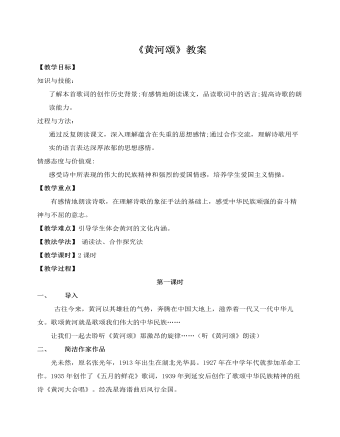
部编版语文七年级下册《黄河颂》教案
六、讨论、探究:1、“黄河的精神”是什么?从本文的哪些词句中可以体会黄河的这种精神?中华民族伟大坚强的精神 2、作者借歌颂黄河表达了怎样的思想感情?作者借歌颂黄河来歌颂中华民族的灿烂文化,歌颂中华民族的伟大精神,歌颂中华儿女的勤劳勇敢、伟大坚强,从而激发整个民族以英勇的气概和坚强的决心来保卫黄河,保卫中国。 3、如何理解黄河是“摇篮”,是“屏障”?把黄河比喻为“中华民族的摇篮”是因为黄河是中华民族的发祥地,黄河哺育、滋养了世代炎黄子孙。把黄河比喻为“民族的屏障”,侧重于黄河对中华民族的保卫作用而言。黄河天险在地理上可作为军事屏障,黄河伟大坚强的精神,更足以成为民族精神上的城防。重点揭谜这是一个比喻句,把黄河比喻为一个巨人,黄河主流是巨人的躯干,黄河流域中的无数条支流就是“巨人”身上千万条“铁的臂膀”。它体现了气势磅礴、勇不可挡的气度和力量,正足以激发民族的精神和信念。
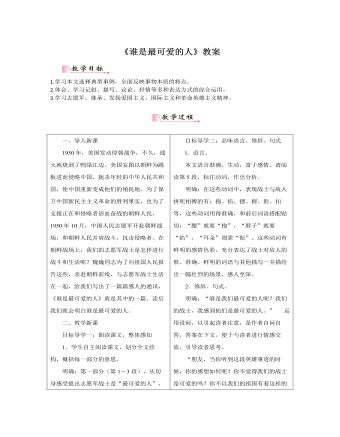
部编版语文七年级下册《谁是最可爱的人》教案
目标导学三:学习综合运用多种表达方式明确:本文以记叙为主,穿插着议论、抒情。第一部分,作者首先抒发了自己的亲身感受,又以“谁是我们最可爱的人”设问作为记叙、议论的中心,接着用一个气势磅礴的排比句揭示了志愿军战士的精神风貌,从意志、品质、气质、胸怀四个方面进行高度评价和赞美,为文章具体事例的叙述做了思想认识方面的提示和感情的铺垫。第二部分,文章以记叙为主,具体叙述了三个典型事例,在叙述完每一个事例后,文章都穿插了议论、抒情。这些议论抒情,既起到深化主题的作用,又增强了文章的感染力。第三部分,作者告诉人们要珍惜战士们用鲜血和生命换来的幸福生活。没有用单调枯燥的说教,而是用朋友的恳谈来启迪人们感受到幸福生活的来之不易。拓展延伸:收集新时代“最可爱的人”典型事迹的资料,准备举办演讲会。
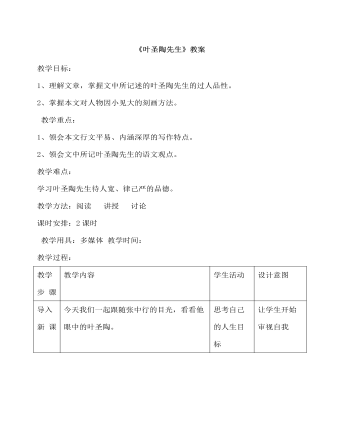
部编版语文七年级下册《叶圣陶先生》教案
一、 作者介绍 张中行,原名张璇,学名张璿,河北省香河县河北屯乡石庄(今属天津市武清区河北屯镇)人,著名学者、哲学家、散文家。主要从事语文、古典文学及思想史的研究。曾参加编写《汉语课本》、《古代散文选》等。合作编著有《文言文选读》、《文言读本续编》;编著有《文言常识》、《文言津逮》、《佛教与中国文学》、《负暄琐话》等。是二十世纪末未名湖畔三雅士之一,与季羡林、金克木合称“燕园三老”。季羡林先生称赞他为“高人、逸人、至人、超人”。 二、初读课文 自由阅读课文,理解重点词句搀和:chān huo 掺杂混合 东四八条:北京东城区胡同名 冗长:rǒng cháng (文章、讲话等)废话多,拉得很长,含贬义 著作等身:形容著作极多,叠起来能跟作者的身高相等。 沾溉:浸润浇灌 高文典册:经典性著作 躬行君子,则吾未之有得:做一个身体力行的君子,那我还没有做到。
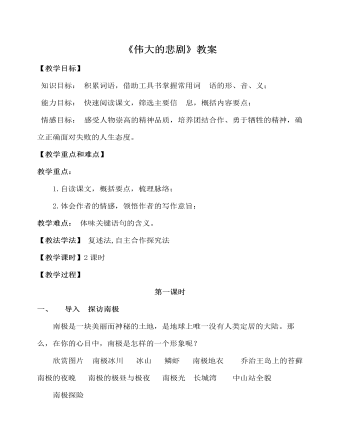
部编版语文七年级下册《伟大的悲剧》教案
千百年来,南极这个亘古长眠的世界一面向世人展示着自己冰肌玉骨、绝世无双的美丽,一面以其层层冰嶂、酷冷奇寒的肃杀之气凛然回绝了人类无数次好奇的拜访。因为那里的天气实在是太恶劣了。而近百年来,无数探索者在南极留下了他们的足迹,他们为人类的进步事业作出了自己的贡献,有的甚至献出了宝贵的生命。1911年,两位著名的探险家挪威人阿蒙森和英国人斯科特踏上了冲击南极点的征程。这两个人都想成为第一个到达南极点的英雄。经过一番激烈的竞争,结果是阿蒙森队捷足先登,于1911年12月14日到达南极,而斯科特队则于1912年1月18日才到达,比阿蒙森队晚了将近五个星期。最后,阿蒙森胜利而归,成功的旗帜永远飘扬在南极点上,而斯科特等五名冲击南极的英雄,因为南极寒冷天气的突然提前到来,饥寒交迫,体力不支,在返回的途中与严寒搏斗了两个多月,最后长眠在茫茫的冰雪之中。
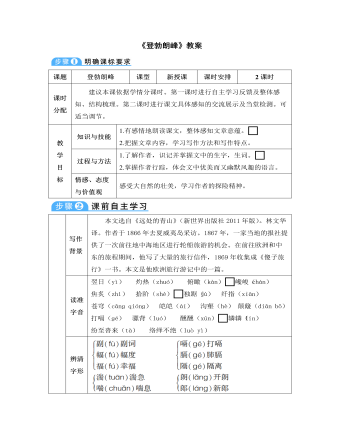
部编版语文八年级下册《登勃朗峰》教案
【初读课文,整体感知】1.文章主要描写了作者上山与下山的经历,这些经历有哪些不同?表达了作者什么样的感受?(1)作者上山时,是以写景散文的笔法,描述了沿途的秀色美景,高山的险峻陡峭,水流的清澈急湍,美不胜收。表达了作者游览时的激动与喜悦。(2)作者下山时,是以叙述小说的笔法,用极为幽默诙谐的写法描述了车夫之王,以及他们惊险而又激动的旅行,富有感染力和传奇色彩。2.本文第4、5段的描写十分精彩,试分析其表达特色和表达效果。选取勃朗峰上的山峰、高地,从视觉的角度描写,远近结合,相映成趣。运用比喻、拟人的修辞手法,生动形象地描绘了陡峭峻拔的山峰、色彩斑斓的天空、飘忽不定晶莹洁白的白云,体现了勃朗峰景色的优美壮丽。

部编版语文八年级下册《壶口瀑布》教案
黄河有令人震撼的刚强的一面,也有如歌如画的柔美的一面——刚柔相济。【品味亮点词语】1.壶口瀑布不是从高处落下,让人们仰观垂空的水幕,而是由平地向更低的沟里跌去,人们只能俯视被急急吸去的水流。“吸”,壶口之水的气势、能量尽显无遗,省去了不少渲染的笔墨。2.于是,只急慌慌地扫了几眼,我便匆匆逃离,到了岸上回望那团白烟,心还在不住地跳…… “急慌慌”“匆匆”“不住地”,用“我”的瞬间系列感观衬托瀑布之险,回应了段首中心句。3.黄河在这里由宽而窄,由高到低,只见那平坦如席的大水像是被一个无形的大洞吸着,顿然拢成一束,向龙槽里隆隆冲去,先跌在石上,翻个身再跌下去,三跌,四跌,一川大水硬是这样被跌得粉碎,碎成点,碎成雾。一连串的“跌”字,把瀑布的来势之猛、落差之大表现得淋漓尽致。
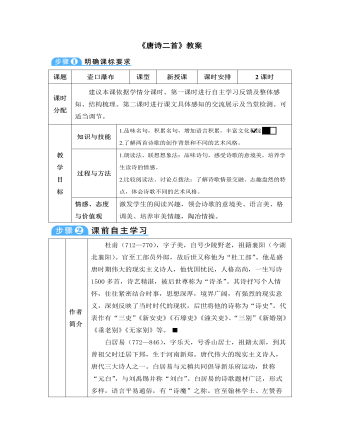
部编版语文八年级下册《唐诗二首》教案
761年8月,成都平原风雨成灾。草堂被吹破了,草堂前的一棵200年的楠树也被拔倒了。〖JP3就在诗人政治上受到冷遇,又加风雨成灾的情况下,杜甫写了《茅屋为秋风所破歌》。〖JP《卖炭翁》:本诗选自《白居易集》卷四(中华书局1979年版)。本诗是白居易《新乐府》组诗中的第三十二首,自注云:“《卖炭翁》,苦宫市也。”白居易写作《新乐府》是在元和(唐宪宗年号,806—820)初年,这正是宫市为害最深的时候。他对宫市十分的了解,又对人民有深切的同情,所以才能写出这首感人至深的《卖炭翁》来。皇宫所需的物品,本来由官吏采买。中唐时期,宦官专权,横行无忌,连这种采购权也抓了过去,常有数十百人分布在长安东西两市及热闹街坊,以低价强购货物,甚至不给分文,还勒索“进奉”的“门户钱”及“脚价钱”。名为“宫市”,实际是一种公开的掠夺。诗人有感于此,写下本诗。
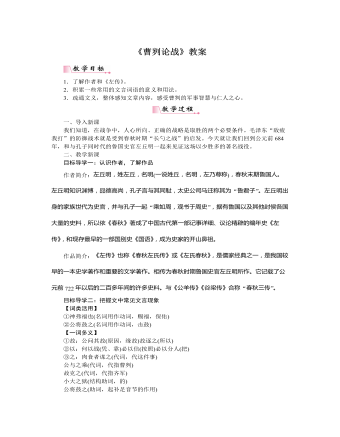
部编版语文九年级下册《曹刿论战》教案
目标导学四:详细解读,体会“论战”智慧1.阅读第一段,说说第一段写了什么内容,可以分为几层。明确:第一段写鲁国战前的准备,可分为两层:第一层(从开始到“乃入见”)写曹刿跟乡人的对话,说明曹刿“请见”的原因;第二层(从“问”到段末)写曹刿跟鲁庄公的对话,说明政治上取信于民是作战的先决条件。2.曹刿的身份是怎样的?为什么他要说“肉食者鄙,未能远谋”呢?明确:从“其乡人曰”句中我们能推知曹刿的身份为普通老百姓,没有官位,属爱国君子,但他“位卑未敢忘国忧”。一句“肉食者鄙”,表明他已经观察到了君主身边未有长策的弊端;而“未能远谋”不仅是对自己深谋远虑的充分肯定,而“远谋”二字,也正是整个论战的核心。3.“何以战”是个宾语前置的句子,这句话引出了下文分析战争的条件,突出了曹刿重视战前的政治准备。鲁庄公认为要做哪几方面的准备呢?

